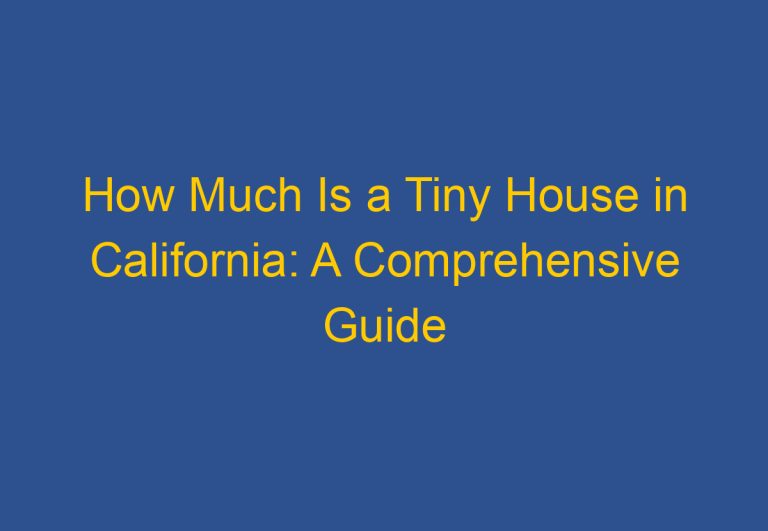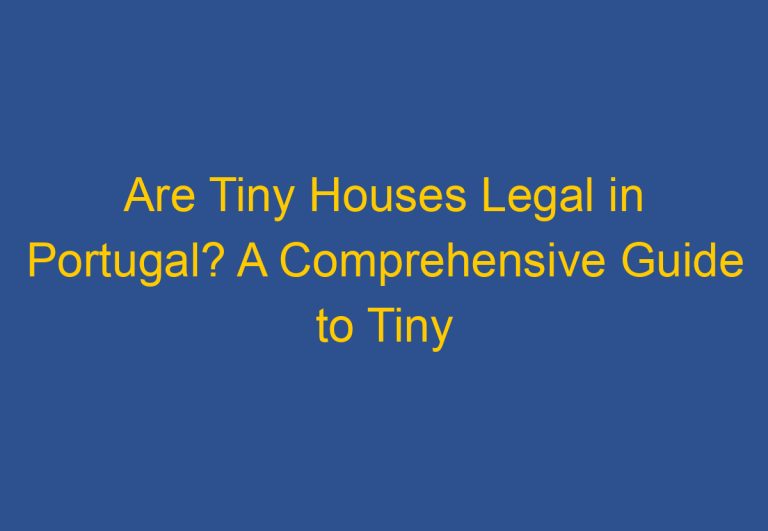Are Tiny Houses Legal in Hawaii? Exploring the Laws and Regulations
Tiny houses have become an increasingly popular housing option in recent years, especially for those looking to downsize or live a more minimalist lifestyle. However, many people are left wondering whether tiny houses are legal in Hawaii.
The good news is that tiny homes are indeed legal in Hawaii, but there are a few things to keep in mind. All homes must adhere to the statewide building code, which stipulates a minimum of 70 square feet of living space and a maximum height of 13.5 feet. Additionally, Hawaii’s counties have special regulations allowing small houses on farms as long as they are at least 220 square feet in size and feature a minimum living area, kitchen, and bathroom.
It’s important to note that some counties permit tiny homes on wheels as long as they meet specific sizes and safety requirements. However, those looking to build or buy a tiny home in Hawaii should be sure to research and adhere to all applicable regulations and building codes to ensure that their home is legal and safe.
Legality and Zoning Regulations
When it comes to tiny houses in Hawaii, there are a number of legal and zoning regulations to consider. Understanding these regulations is critical for anyone looking to construct or live in a tiny house in the state.
Statewide Building and Zoning Laws
While there are no statewide building codes in Hawaii, there are zoning regulations that can impact the construction and placement of tiny homes. In general, tiny houses must comply with local zoning laws and building codes in order to be considered legal.
County-Specific Rules and Requirements
Each county in Hawaii has its own set of rules and requirements for tiny houses. For example, Hawaii County allows small houses on farms as long as they are at least 220 square feet in size and feature a minimum living area, kitchen, and bathroom. Some counties permit tiny homes on wheels as long as they meet specific sizes (between 100 and 400 square feet) and safety requirements.
Tiny Houses on Wheels and RV Classification
In Hawaii, tiny houses on wheels are generally classified as recreational vehicles (RVs). This means that they must meet certain safety and construction standards in order to be registered with the Department of Motor Vehicles. Additionally, some counties have specific regulations for RVs and mobile homes that may impact the legality of tiny houses on wheels.
Land Use and Location Considerations
Zoning and land use regulations in Hawaii can affect where you’re allowed to place your tiny home. These regulations are put in place to protect the environment and maintain the economic feasibility of the area. When it comes to the environmental impact, these regulations aim to prevent harm to natural resources and wildlife habitats. For example, some areas may be designated as agricultural land, which may limit the types of dwellings that can be constructed.
Construction and Safety Standards
Tiny houses in Hawaii must meet certain construction and safety standards in order to be considered legal. This includes requirements for foundation, ceiling height, and other specifications.
Utility and Infrastructure Requirements
In order to be considered legal, tiny houses in Hawaii must also meet certain utility and infrastructure requirements. This includes access to water, sewer, and electricity, as well as compliance with any local regulations related to off-the-grid living.
Living in Tiny House Communities
There are a number of tiny house communities in Hawaii, including Cinderland Eco Village and Tiny Pacific Houses. These communities offer a unique living experience for those interested in tiny house living. However, it’s important to understand any regulations or rules that may apply to these communities before making a decision to live there.
Ownership and Rental Opportunities
Tiny houses in Hawaii can be owned or rented, depending on the individual’s preferences and financial situation. There are a number of companies that sell and rent tiny houses in the state, including Habitats Hawaii and Paradise Tiny Homes.
Special Considerations for Native Hawaiians
There are a number of special considerations for Native Hawaiians who are interested in tiny house living. For example, some Native Hawaiians may be interested in constructing tiny houses on land that is designated for agricultural purposes or that has cultural significance. It’s important to understand any regulations or requirements that may apply in these situations.
Design and Lifestyle
Maximizing Small Living Spaces
Living in a tiny house requires a unique approach to designing and organizing living spaces. With limited living space, tiny homeowners must be creative and efficient in their use of space. Built-in furniture, such as foldable tables and beds, can help maximize living space and make the most out of every square foot. Storage is also a crucial component of a tiny home, with many tiny homeowners utilizing vertical space and hidden storage solutions to keep their homes organized and clutter-free.
Sustainable and Off-Grid Living
Tiny homes offer a unique opportunity for sustainable and off-grid living. Many tiny homeowners incorporate sustainable features such as solar power, rainwater collection, and composting toilets into their homes. These features not only reduce the environmental impact of a tiny home but also offer a sense of self-sufficiency and independence. Living off-grid can also offer financial benefits, with many tiny homeowners reducing their monthly expenses by eliminating utility bills.
Cultural and Community Impact
Tiny homes have gained popularity in recent years, with many communities across the country embracing the tiny house movement. In Hawaii, tiny homes offer a unique opportunity to connect with the local culture and community. Many tiny homeowners in Hawaii have embraced the concept of “aloha” and strive to live in harmony with the environment and their neighbors. Tiny homes can also offer a sense of community, with many tiny home communities forming across the state.
Comparisons to Other States
While Hawaii is known for its strict zoning restrictions and high cost of living, it is not the only state where tiny homes are legal. States like Oregon have embraced the tiny house movement, with many cities and counties allowing tiny homes on wheels as ADUs (accessory dwelling units). Tiny homes offer an affordable and sustainable housing option for those looking to downsize or live off-grid, and their popularity continues to grow across the country.
In Hawaii, the statewide building code requires a minimum of 70 square feet of living space and a maximum height of 13.5 feet for all homes, including tiny homes. However, each county has its own set of regulations and requirements for tiny homes, including size restrictions, setbacks, and parking requirements. It is important for anyone considering building or living in a tiny home in Hawaii to research and understand the specific regulations in their area, as well as any restrictive covenants (CC&Rs) that may apply.
Frequently Asked Questions
What are the zoning regulations for tiny houses in Hawaii?
The zoning regulations for tiny houses in Hawaii vary by county. Most counties allow tiny houses on wheels if they meet certain size and safety rules. One important rule is that the tiny house must be no taller than 13.5 feet, so it can pass under bridges and other low-hanging things when being transported. The width can vary depending on the county, but is usually between 8.5 and 10 feet. Hawaii’s counties have special regulations allowing small houses on farms as long as they are at least 220 square feet in size and feature a minimum living area, kitchen, and bathroom. Some counties permit tiny homes on wheels as long as they meet specific sizes (between 100 and 400 square feet) and safety requirements.
Can tiny houses be legally placed on any type of land in Hawaii?
No, tiny houses cannot be legally placed on any type of land in Hawaii. The land must be zoned for residential use and meet the minimum size requirements. Additionally, if the tiny house is on wheels, it must be parked on a foundation that meets the requirements of the local zoning code.
What permits are required to build a tiny house in Hawaii?
The permits required to build a tiny house in Hawaii depend on the location and the type of tiny house being built. In general, a building permit is required for any structure that is intended for human habitation. Additionally, if the tiny house is on wheels, it may be subject to additional regulations and permits related to transportation and parking.
Are there specific building codes for tiny houses in Hawaii?
There are no specific building codes for tiny houses in Hawaii. However, tiny houses must still comply with the building codes and safety standards that apply to all residential structures. This includes requirements for electrical, plumbing, and ventilation systems, as well as fire safety and structural integrity.
Is it possible to join a tiny home community in Hawaii?
Yes, it is possible to join a tiny home community in Hawaii. There are several tiny home communities throughout the state that offer a variety of amenities and services. These communities are typically designed to promote sustainable living and provide a sense of community for residents.
How does the cost of living in a tiny house in Hawaii compare to traditional housing?
The cost of living in a tiny house in Hawaii can vary widely depending on the location, size, and amenities of the tiny house. In general, tiny houses are less expensive to build and maintain than traditional houses, but they may have higher upfront costs for things like land and infrastructure. Additionally, the cost of living in a tiny house may be lower than traditional housing due to reduced energy and utility costs.










